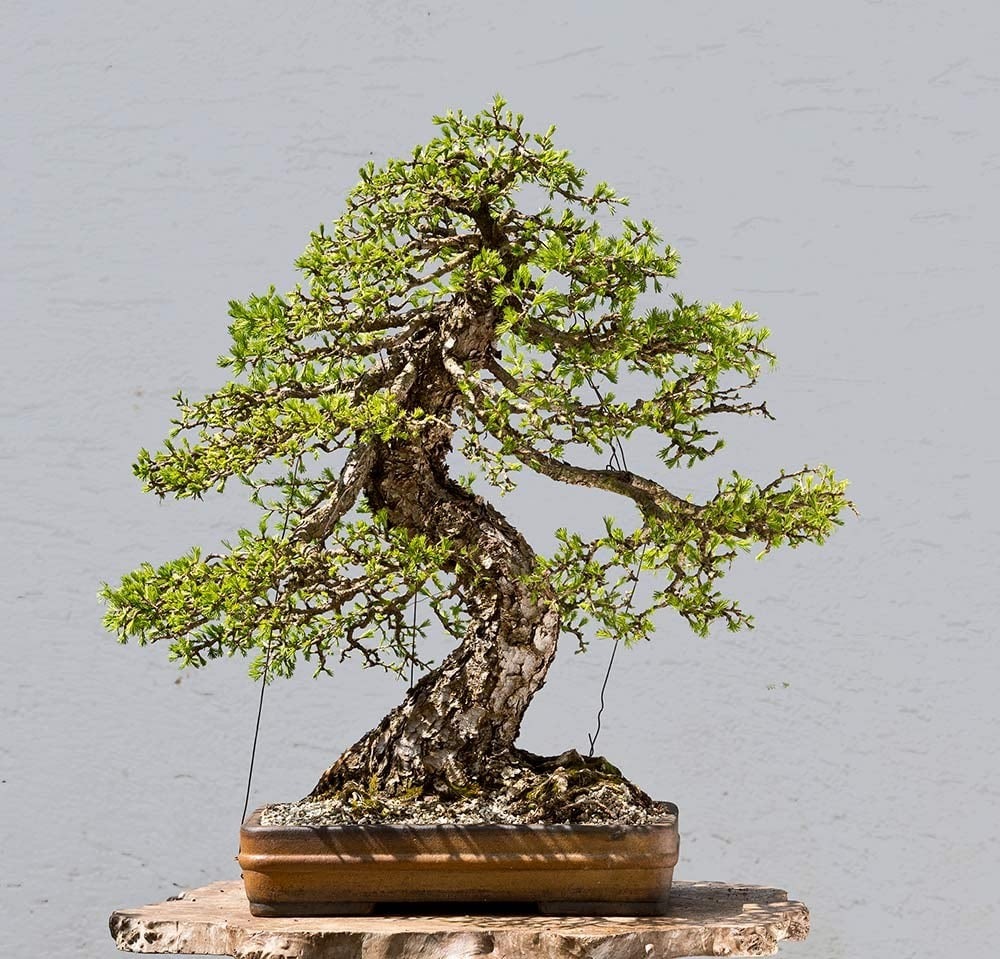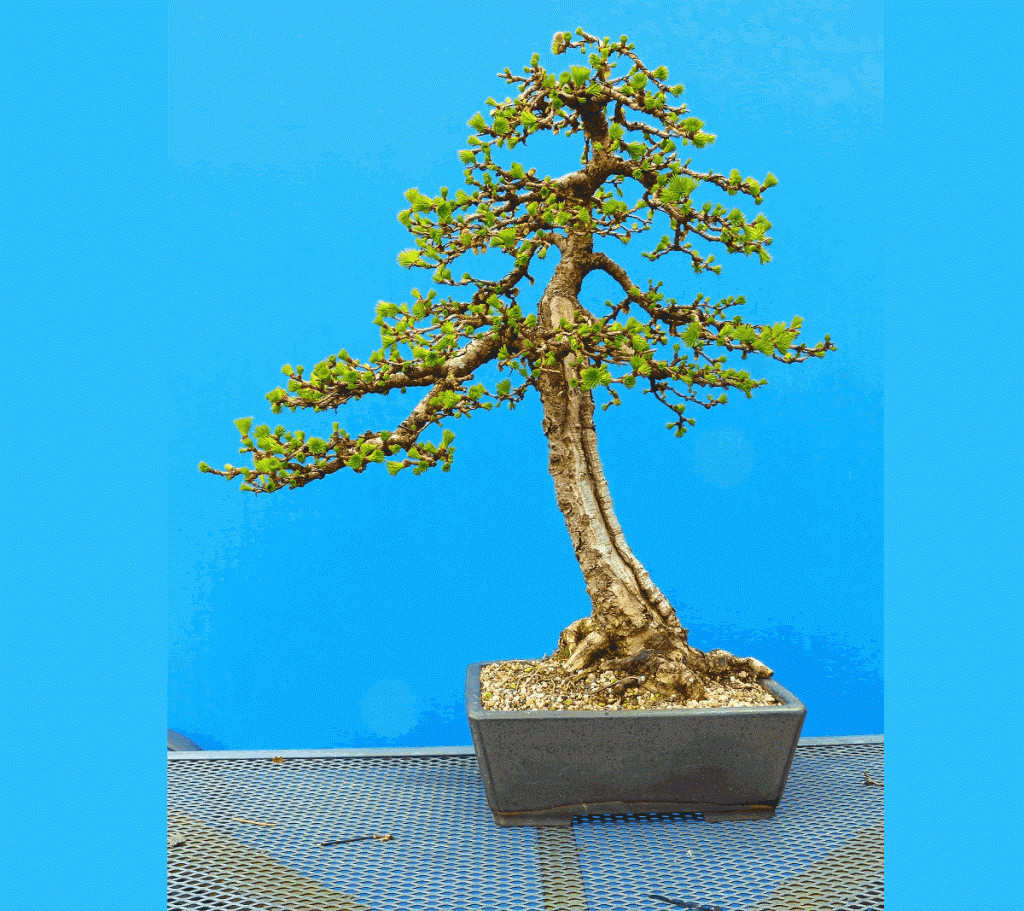Larch bonsai, a favorite among bonsai enthusiasts, offers a unique blend of beauty and challenge. Unlike many evergreen species, the larch is deciduous, shedding its needles in the winter. This characteristic makes it a dynamic choice for those looking to expand their bonsai collection.
Why Choose Larch Bonsai?

Larch bonsai is cherished by enthusiasts for its dramatic and vibrant seasonal changes, which make it a dynamic addition to any bonsai collection. In spring, the tree awakens with the emergence of soft, bright green needles that give it a fresh and lively appearance. As the seasons progress, these needles mature, creating a lush, full canopy. By autumn, the foliage undergoes a breathtaking transformation, turning a rich golden yellow that contrasts beautifully with the deep greens of other trees. This striking color change is one of the most appealing aspects of larch bonsai, as it offers a stunning visual display that evolves throughout the year. Additionally, the deciduous nature of larch bonsai means that in winter, its bare branches reveal the elegant structure and intricate branch patterns, adding another layer of beauty to its year-round appeal. This continual transformation makes the larch bonsai not just a plant, but a living piece of art that reflects the passage of time and the changing seasons.
Optimal Growing Conditions for Larch Bonsai
To cultivate a healthy and thriving larch bonsai, it’s essential to provide the right environmental conditions. Larches are native to cold climates, and they thrive best in regions where they can experience a distinct winter dormancy period. This dormancy is crucial for their health, as it allows the tree to rest and prepare for the next growing season. During the growing season, larch bonsai requires full sun exposure to maintain its vigor and promote healthy needle and branch development. The ample sunlight not only helps in photosynthesis but also enhances the color intensity of the foliage, contributing to the tree’s overall aesthetic appeal. It’s important to note that while larch bonsai can tolerate some shade, insufficient light can lead to weak growth and a less vibrant display. Therefore, positioning your bonsai in a spot where it can receive plenty of sunlight is key to ensuring its long-term health and beauty.
Soil and Watering Requirements
Larch bonsai has specific soil and watering needs that must be met to prevent issues such as root rot and to support its growth. The tree prefers well-draining soil, which is crucial for preventing water from pooling around the roots and causing rot. A balanced soil mix that includes akadama (a type of clay granule), pumice, and lava rock is ideal, as it provides the right combination of drainage and moisture retention. Akadama helps retain moisture and nutrients, while pumice and lava rock ensure good aeration and prevent the soil from becoming compacted. During the growing season, larch bonsai requires regular watering to keep the soil consistently moist, but not waterlogged. It’s important to monitor the moisture level, as the soil should be allowed to dry slightly between waterings to avoid creating overly wet conditions that could harm the roots. In winter, watering can be reduced, as the tree’s water needs decrease during dormancy. By carefully managing the soil and watering regimen, you can ensure that your larch bonsai remains healthy, vibrant, and resilient.
Pruning and Wiring Techniques
Pruning is a fundamental aspect of maintaining and shaping your larch bonsai, ensuring it develops the desired aesthetic and structural form. Regular pruning involves selectively trimming new growth to refine the shape and encourage denser foliage. This practice not only helps maintain the bonsai’s silhouette but also promotes better air circulation and light penetration within the canopy, which is essential for the tree’s overall health. The timing of pruning is crucial; it’s best done during the growing season when the tree is actively producing new shoots. By carefully removing unwanted branches and pinching back new growth, you can guide the tree’s shape and prevent it from becoming overgrown.
Wiring is another important technique used in bonsai cultivation, particularly for larch bonsai, which has naturally flexible branches. This flexibility makes the larch an excellent candidate for wiring, allowing you to create intricate and expressive designs that enhance the tree’s artistic appeal. Wiring is best done during the dormant season, typically in late autumn or winter, when the tree is not actively growing. This reduces the risk of damaging the tree and allows the branches to set in their new positions as growth resumes in the spring. When wiring, it’s important to be gentle and avoid applying too much pressure, as this can damage the bark or leave unsightly scars. The wire should be checked regularly and removed or adjusted as the tree grows to prevent it from cutting into the bark. With careful pruning and wiring, your larch bonsai can be shaped into a beautiful and unique work of living art.
Repotting Your Larch Bonsai
Repotting is a vital part of bonsai care, helping to refresh the soil, promote healthy root growth, and prevent the tree from becoming root-bound. For larch bonsai, repotting should be done every 2-3 years, depending on the tree’s growth rate and root development. The optimal time for repotting is in early spring, just before the new growth begins. At this stage, the tree is still dormant, making it less vulnerable to the stress of repotting.
When repotting your larch bonsai, start by carefully removing the tree from its pot. Gently tease out the roots, removing any old soil that may have compacted around them. It’s important to trim the roots slightly during this process, as this encourages the growth of new feeder roots, which are essential for the tree’s absorption of water and nutrients. Be careful not to remove too much of the root mass, as this can stress the tree. After trimming, place the bonsai into a pot with fresh, well-draining soil, ensuring that the roots are spread out evenly. The new soil mix should be tailored to the needs of the larch, typically consisting of a blend of akadama, pumice, and lava rock, which provides the right balance of drainage and moisture retention.
After repotting, water the tree thoroughly to settle the soil and remove any air pockets. It’s also advisable to keep the tree in a shaded, sheltered location for a few weeks to allow it to recover from the repotting process. By following these steps, you can ensure that your larch bonsai remains healthy, vibrant, and well-structured for years to come.
Pest and Disease Management
Larch bonsai, like all plants, can be vulnerable to various pests and diseases, which can affect its health and appearance if not managed properly. Common pests that may attack larch bonsai include aphids, spider mites, and scale insects. These pests can cause damage by sucking sap from the leaves and stems, leading to weakened growth, discoloration, and in severe cases, the death of branches. Regular inspection of your bonsai is essential to detect any signs of infestation early. Look for symptoms such as yellowing leaves, sticky residue (honeydew) on the foliage, or visible pests on the needles and branches.
If pests are detected, prompt treatment is necessary to prevent the infestation from spreading. Insecticidal soap or neem oil are effective and commonly used treatments that can control these pests without harming the bonsai. Insecticidal soap works by suffocating the pests, while neem oil acts as a natural pesticide and repellent. When applying these treatments, make sure to cover all parts of the tree, including the undersides of leaves and the joints between branches and stems, where pests often hide.
In addition to pests, larch bonsai can also be susceptible to fungal diseases, especially if it is kept in conditions with poor air circulation or excessive moisture. Common fungal issues include powdery mildew and root rot, which can be devastating if left untreated. To prevent fungal infections, ensure that your bonsai is placed in a location with good air circulation and avoid overwatering, particularly during cooler, damp periods. If you notice any signs of fungal disease, such as white powdery patches on the leaves or soft, blackened roots, take action immediately by pruning affected areas and applying a suitable fungicide.
By maintaining a regular care routine that includes inspection, treatment, and proper environmental management, you can keep your larch bonsai healthy and free from pests and diseases.
Winter Care for Larch Bonsai
As winter approaches, larch bonsai enters a period of dormancy, during which its growth slows down, and it requires specific care to ensure it remains healthy throughout the colder months. Larch bonsai is adapted to cold climates and needs this period of dormancy to thrive, so it is important not to interrupt this natural cycle. However, while larch can tolerate cold temperatures, it is still crucial to protect it from extreme cold, especially if you live in a region with harsh winter conditions.
If your area experiences severe frosts or prolonged periods of freezing temperatures, consider moving your bonsai to a more sheltered location, such as an unheated garage, shed, or cold frame. A cold frame provides protection from the worst of the winter weather while still allowing the bonsai to experience the necessary cold period. It’s important to monitor the temperature inside the cold frame to ensure it remains within a safe range for the bonsai.
Avoid bringing your larch bonsai indoors during winter, as the warmer indoor temperatures can disrupt its dormancy, leading to poor growth and health issues in the following growing season. If your bonsai is kept outdoors, consider placing a layer of mulch or straw around the base of the pot to insulate the roots and protect them from freezing.
Additionally, reduce watering during the winter months, as the tree’s water requirements decrease during dormancy. Water sparingly, only when the soil is dry to the touch, to prevent the roots from becoming waterlogged and susceptible to rot. By providing the right winter care, you can ensure that your larch bonsai emerges from dormancy strong and ready for the new growing season.

Conclusion: Embrace the Challenge of Larch Bonsai
Cultivating larch bonsai is a rewarding experience. With its striking seasonal changes and the challenges it presents, this bonsai is perfect for both beginners and experienced growers. By providing the right care, you can enjoy the beauty of larch bonsai for years to come.
